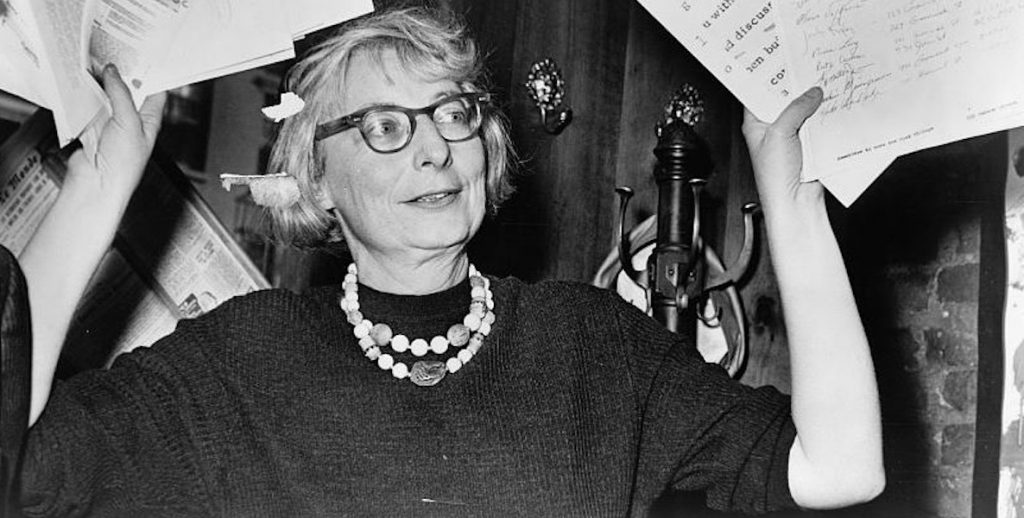In the late 1950s, Jane [Jacobs] visited Philadelphia. There she joined the already legendary Edmund Bacon, on his way to the cover of Time for his leadership of the city’s redevelopment programs, for a tour, letting him show off to her all he was proudest of.
A native Philadelphian, 45, born of a staunchly conservative publishing family, Bacon was a graduate of Cornell’s school of architecture. He’d used an inheritance from his grandfather to travel the world, had wound up in Beijing, won a fellowship to study city planning at the University of Michigan, worked as a planner in Flint. By 1949, he was back in Philadelphia, pushing his ideas through the local bureaucracy, determined to clear away the debris of the city’s industrial past and create gleaming new modernist vistas; the city had not seen a major new office building go up in almost 20 years.
Not everyone liked him. “Arrogant, arch, pompous and wrong,” an architect who knew him later, Alan Littlewood of Toronto, would blithely call him. But Bacon, it could seem, was not just Philadelphia’s master planner, but America’s.
On Jane’s visit, Bacon treated her at one point to a kind of before-and-after exercise in urban redevelopment. First they walked along a down-and-out street in a black neighborhood destined later for the Bacon treatment. It was crowded with people, people spilling out onto the sidewalk, sitting on stoops, running errands, leaning out of windows. Here was Before Street. Then it was off to After Street, the beneficiary of Bacon’s vision — bulldozed, the unsavory mess of the old city swept away, a fine project replacing it, all pretty and new. Jane, Bacon urged her, stand right here, look down this street, look what we’ve done here.
Where are the people? Why is no one here?
The way Jane told the story, Bacon didn’t offer a Yes, but … by way of explanation. He didn’t say, Well, in a few years, as the neighborhood matures, we’ll see … He offered no explanation at all. To Jane, he just wasn’t interested in her question, which irritated the hell out of her. She was puzzled, he wasn’t, and that was itself noteworthy.
But more, for Jane the two streets seemed to point up some opposing lesson, or value, or idea, from that of Bacon — some sharply different sense of what mattered in a city and what did not, a divergent way of seeing. For Bacon, the new street exemplified all that was best in the new world that planners like him were making. For Jane, Bacon’s perspective was narrowly aesthetic, a question mostly of how it looked; to her, the new street represented not entirely a gain over the old, maybe no gain at all, but a loss, one that mocked Bacon’s plans and drawings and the glittering future they promised. “Not only did he and the people he directed not know how to make an interesting or a humane street,” she’d say, “but they didn’t even notice such things and didn’t care.”
What she saw in Philadelphia was that the new projects didn’t look the way they were supposed to look and, more important, didn’t work the way they were supposed to work. What Jane found in Philadelphia was these visions didn’t match the city she met on the ground—not, at least, in ways that mattered to her.
She did. And certainly she could appreciate the vista Bacon offered her; Yes, it’s very nice. But there was something missing: People. Especially so in contrast to that first street, which Jane recalled as lively and cheerful. Here, amid the new and rehabbed housing, what did she see? She saw one little boy — she’d remember him all her life — kicking a tire. Just him, alone on the deserted street.
What she saw in Philadelphia was that the new projects didn’t look the way they were supposed to look and, more important, didn’t work the way they were supposed to work. Not if the boy kicking the tire down the street was any indication. Not if projects she’d heard glowingly described, or had even written about, were turning out as they did.
Excerpted from Eyes on the Street: The Life of Jane Jacobs. Copyright © 2016 Robert Kanigel. Published by Alfred A. Knopf, a division of Random House Ltd., a Penguin Random House Company. Reproduced by arrangement with the Publisher. All rights reserved. On October 27, Kanigel will be appear at the Free Library. For information and tickets, go here.

